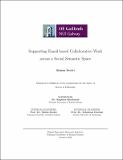| dc.description.abstract | The Social Semantic Desktop adopts Semantic Web technology on the desktop to provide a universal platform for personal - and distributed - information management, social networking and community creation. The social semantic desktop extends the personal desktop across two dimensions: socially and semantically. The semantic aspect relies on the lifting of desktop information onto a semantic representation. A set of high-level ontologies, including a novel representational language, was engineered to enable such representation. The social aspect relies on semantically-enabled, inter-desktop, communication and information exchange media. As a crucial business communication tool, electronic e-mail was immediately identified as a medium that can undergo such a transformation. Moreover, e-mail is more than just a means of communication, often serving as a virtual extension to the user's working environment, wherein they collaborate; generating and sharing new information in the process. However, although e-mail is a valuable source of desktop information, it also suffers from a number of information management problems. The overall effect of these problems is termed e-mail overload, and results in the users becoming overwhelmed by the amount and diversity of incoming information, eventually losing track of important tasks and commitments. Furthermore, the ensuing information (mis)management issue at hand is of an interpersonal nature, with one's failures affecting the productivity of an entire collaborative network. Therefore, before enabling e-mail technology with semantics, this problem needed to be adequately addressed.
In comparison to a myriad of other approaches, this thesis targets what is considered to be the source of e-mail overload: the lack of support for the underlying ad-hoc e-mail workflows. An attempt is made to structure the underlying communication processes, in view of the possibility of enabling machines to support them. The conceptual building blocks for e-mail workflows - action items - derive from computationally-treatable aspects of speech act theory. Models for representing different kinds of e-mail action items, and ensuing workflows, are introduced. Knowledge in these models is exposed to machines via an ontology, itself deriving from the higher-level social semantic desktop ontologies. The latter are used to represent additional shared workflow artefacts, such as messages executing the workflows, contacts (participants) involved, resulting tasks and events, attached files, etc. Information extraction techniques are employed for the semi-automatic elicitation of action items, whereas additional information about the ensuing workflows is elicited through user interaction, either indirectly or at a minor cognitive cost. Powered by these technologies, an intelligent user interface provides on-the-fly e-mail workflow support, without exposing the user to the complexity of the underlying models.
The proof of concept for the proposed solution is provided via Semanta -- a semantic communication support system that enables semantic e-mail, to assist the user with the better management of e-mail-based, cross-desktop, collaborative work. Thus, Semanta also fosters data integration across a network of social semantic desktops. With semantic technology seamlessly-integrated within the existing technical landscape, Semanta does not require users to familiarise with new e-mail clients or transport technologies.
Whereas workflow management and visualisation is provided alongside that conventionally provided for e-mail messages, workflow processing is performed in parallel to habitual e-mail use, such as reading and replying to messages. An evaluation of the system indicates that, although there is further room for improvement, Semanta already provides additional support to the collaborative e-mail user. The results imply that, coupled with semantically-enabled desktops, there is a huge potential for semantic communication support systems to improve cross-desktop collaboration taking place over internet-based, written forms of communication, such as e-mail. | en |
| dc.local.note | Information on the desktop reaches enormous proportions, and finding information when needed has become a problem. One source of information is Email. Email can be overwhelming, not only in terms of the number of emails reaching one's computer, but especially - in a business context - with regards to keeping up with the action items requiring attention within. A lot of requests, questions, suggestions and task delegations are carried out over email, and people using email rely on their successful answering or completion. The use of semantic technology has been investigated to enable intelligent plugins to existing email clients, that help the users with better keeping track, managing and visualising all their email tasks. | en |


